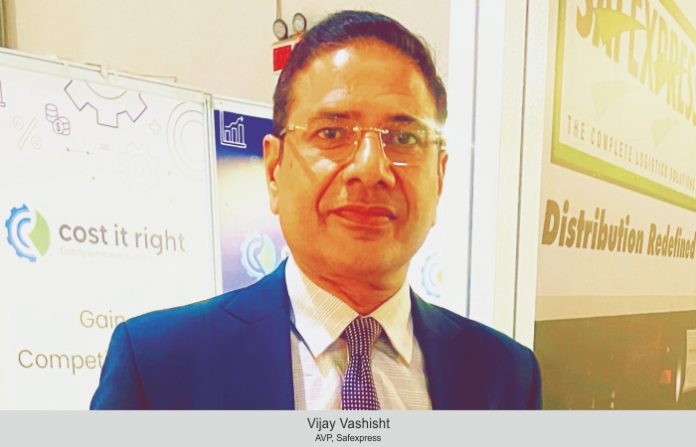Safexpress offers warehousing and transportation solutions to its customers worldwide through advanced tech. Its focus is on multimodal services, including surface and SafeAir transport. Apart from offering SafeAir connectivity to and from 54 airports by roads, Vijay Vashisht, AVP says rail and waterways are yet to become a part of our offerings.
CT Bureau
How important has it become for firms to design future supply chains, which are cost-effective, resilient, and can meet evolving customer needs?
Many units in value chains were struggling to operate smoothly during COVID and this has increased the volatility in prices thereby preventing it to flow freely between geographies. The churning brought forth the need for players to reshape strategies. It is important to realize that the world of value chain is connected and inter-dependent. A disturbance here or there can have a debilitating world-wide effect.
All said and done, it is crucial to remember that logistics and supply chains operate as an extension of manufacturing in the value chain and end-to-end integration. The industry has undergone changes with the introduction of new practices and trends. It is the need of the hour to design supply chains that are robust and future ready.
Today, the expectation for on-time delivery has forced logistics firms to collaborate with ecosystem partners. How challenging has it become for LSPs to meet customers’ expectations?
There was a time when shippers and customers were not able to track shipments. They would patiently wait for their shipments to reach the destinations. But, today, all the parties involved can trace their shipments instantly through online phone-based order tracking apps, along with comparable real-time processes. However, following a boom in online retail put the consumers at the centre of marketing strategy. B2C businesses ran the risk of impulse buying and success meant that delivery is done before the interests of the consumer wane. Smart AI configurations coupled with ultra-local delivery model ensured that consumer interest in the product and the platform is retained. Industry accelerated its game and innovated to find solutions; another model of B2B Online Retail has developed.It requires product availability. Certain innovations such as an online retail platform joining hands with local kirana shops and its modern variant in omni-channel provisioning of products has given the time-sensitive consumers an option. It could not make headway, because it did not generate consumer interest. Co-loading has been in practice at some level and developed as an option for those who have the products.
Having said that, I appreciate the nature and family of products that are time and cost-sensitive or both. Industry has different channels to serve that. Yes, things have changed a lot. Indian customers today expect the best services at the most competitive prices. And stiff competition would ensure that this would remain so.
What are the key emerging trends in logistics sector and, according to you, what are the areas that need immediate attention?
Technology utilization is one of the biggest changes. Some developments and trends are worth pointing out. They are as following:
Demand for cold supply chain: The pharma sector has been driving up demand for cold storage facilities for movement of COVID vaccines and life-saving drugs. Also, boom in e-commerce, especially ready-to-eat products, and frozen foods, has increased the need for cold storage facilities.
Growth in 3PL and 4PL companies: Many sectors have started outsourcing chain management functions thereby increasing preference for third-and fourth-party service providers in the logistics sector. The 3PL market may grow at 11.5 per cent by 2025.
Adoption of technology: Internet of Things, AI, ML techniques help firms deal with demand fluctuations. They help in reducing operating costs too. Robotics helps logistics firms to increase the speed and accuracy of supply chain processes. Collaborative robots called Co-Bots and Autonomous Mobile Robots, are being deployed to transport goods to warehouses and storage facilities. Drone technology, Automation, Blockchain, Use of Data Analytics and Cloud Computing boost efficiency, transparency, and speed.
Tell us about the recent investments in supply chain and warehousing sector. What are the key growth drivers for this year?
Our core values constitute speed, safety, and network/connectivity. This strategy of investment-led growth means investment in capacity expansion. In our industry, capacity expansion means adding more warehousing space, modern hub facilities, trucks, and people who operate these. Our warehouses are inbuilt with multiple platforms, facilitating loading and unloading and a quicker turnaround time for vehicles.
These warehouses are equipped with cantilever shades that neutralize risks in inclement weather. We also have advanced GPS-based tracking and are using bar code technology for quite a few years now. In recent years, we have enhanceda with cloud ERP solution and created interlinkages of different segments. We also introduced services such as last leg operations in modern retail outlets, where timing and service are critical. We have been offering this service on a surcharge basis. Yes, we are yet to explore this in a holistic manner.
How beneficial are initiatives such as Gati Shakti for growth of logistics sector in India.
Growth-oriented initiatives such as Gati Shakti are beyond doubt. They are crucial for the growth of an economy. In less than a year, Gati Shakti’s approach has pushed players to become more proactive. It looks at providing multimodal connectivity infrastructure to various economic zones. It pushed to develop its seven growth engines, namely, Railways, Roads, Ports, Waterways, Airports, Mass Transport and Logistics infra. It aims to provide holistic growth that drives innovation, creates jobs, and makes business easier.
What is crucial to keep the momentum going?
There still are many loose ends that need to be tied. Structural issues like hoarding and efficiency apart from the regular challenges of upgradation and imbalance in export and import. Transload operates independently but the efficiency of which is again dependent upon inflationary pressures.
Share with us your plans to build MMLPs and projects in pipeline.
We believe MMLP parks are the future. Currently, our services include surface and SafeAir ops. The SafeAir cargo movement and distribution is complimentary to its surface distribution network. We provide SafeAir connectivity to and from 54 airports, well-connected to our SafeAir offices and surface network to enable faster TAT.Waterways and rail logistics are yet to become a part of our offerings though.















